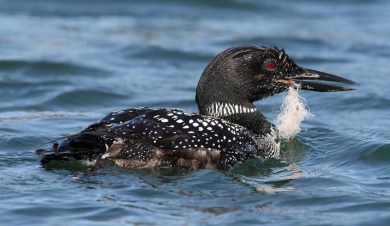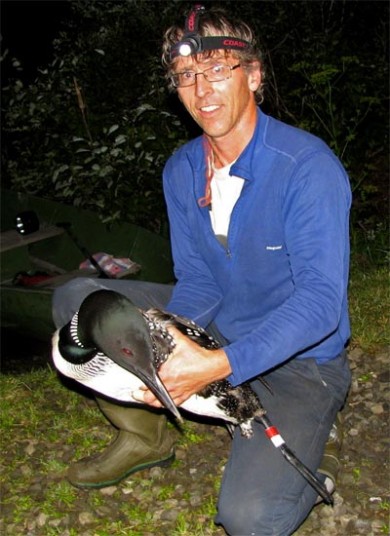 Common Loons sometimes find themselves in uncommon situations. They might land on wet roads or small ponds lacking a suitable “water runway” for takeoff. Loons sometimes ingest fishing lures and line. Or they might be caught on frozen ponds in early and mid winter.
Common Loons sometimes find themselves in uncommon situations. They might land on wet roads or small ponds lacking a suitable “water runway” for takeoff. Loons sometimes ingest fishing lures and line. Or they might be caught on frozen ponds in early and mid winter.
As leader of the Vermont Loon Conservation Project, VCE rescues loons in distress. Often with help from citizen naturalists, we get loons back on the water or in the air.
If You Find a Loon in Trouble
- Do not try to rescue a Common Loon on your own. Injured loons can be dangerous when handled.
- If the loon needs immediate attention (at risk of drowning, for example, or in traffic), call VCE Loon Biologist Eric Hanson (802-586-8065). If you can’t reach Eric, contact the Vermont State Police to reach a state game warden. Here’s a list of the 12 Vermont State Police Barracks and their phone numbers.
 Please note that people sometimes mistake ordinary loon behavior for distress. These behaviors might include a loon frantically flapping about on the surface of the water, wing-rowing followed by splashing, rolling over, sticking one wing out and flapping it, reaching repeatedly with its bill to one part of its body. These can be the behaviors of a loon taking a good, cleansing bath. The loon is flushing its feathers with water to remove feather and skin parasites. At some point the loon will calm down and start re-oiling its feathers by reaching back to the oil gland at its hind end.
Please note that people sometimes mistake ordinary loon behavior for distress. These behaviors might include a loon frantically flapping about on the surface of the water, wing-rowing followed by splashing, rolling over, sticking one wing out and flapping it, reaching repeatedly with its bill to one part of its body. These can be the behaviors of a loon taking a good, cleansing bath. The loon is flushing its feathers with water to remove feather and skin parasites. At some point the loon will calm down and start re-oiling its feathers by reaching back to the oil gland at its hind end.- Watch the loon and make notes of its behavior. Is it swimming? Diving? Feeding? Preening? Does it swim in circles or float lopsided in the water? Does it beach itself? Can you see fishing line around the bill or body? Does the loon appear to be trying to remove something with its bill? Keep an eye on where the bird goes. This information will be valuable in deciding what to do next.
- If the distress continues and is affecting the loon’s ability to function, contact Loon Biologist Eric Hanson at 802-586-8065 or by email at . If the bird is swimming calmly or is on shore in a safe area, wait for a return call.
- Please recognize that rescues are only one option. Watching may be in the best interest of the bird, whether to let “nature take its course” on a diseased or naturally injured loon or to wait for a loon entangled in fishing gear to get weak enough for us to catch it. For a loon clearly in trouble (e.g., caught in fishing line), we often wait a few days to set up capture attempt with local volunteers. Loons are tough and can go without food for over a week.
